
Frank Lloyd Wright was an American architect, designer, writer, and educator. He designed more than 1,000 structures over a creative period of 70 years. Wright played a key role in the architectural movements of the twentieth century, influencing architects worldwide through his works and hundreds of apprentices in his Taliesin Fellowship. Wright believed in designing in harmony with humanity and the environment, a philosophy he called organic architecture. This philosophy was exemplified in Fallingwater (1935), which has been called "the best all-time work of American architecture".

The Go-Between is a novel by L. P. Hartley published in 1953. His best-known work, it has been adapted several times for stage and screen. The book gives a critical view of society at the end of the Victorian era through the eyes of a naïve schoolboy outsider.

David Hartley was an English philosopher and founder of the Associationist school of psychology.

Marie Louise Hartman, known professionally as Nina Hartley, is an American pornographic film actress described by CNBC as "a legend in the adult world".

Hartley Coleridge, possibly David Hartley Coleridge, was an English poet, biographer, essayist, and teacher. He was the eldest son of the poet Samuel Taylor Coleridge. His sister Sara Coleridge was a poet and translator, and his brother Derwent Coleridge was a scholar and author. Hartley was named after the philosopher David Hartley.
Leopold Hamilton Myers was a British novelist.

Leslie Poles Hartley was a British novelist and short story writer. Although his first fiction was published in 1924, his career was slow to take off. His best-known novels are the Eustace and Hilda trilogy (1944–47) and The Go-Between (1953). The latter was made into a film in 1971, as was his 1957 novel The Hireling in 1973. He was known for writing about social codes, moral responsibility and family relationships. In total, Hartley published 17 novels, six volumes of short stories and a book of criticism.
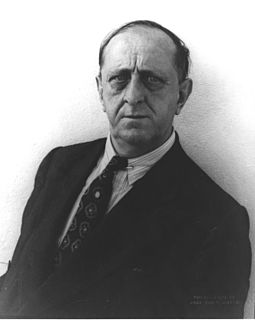
Marsden Hartley was an American Modernist painter, poet, and essayist. Hartley developed his painting abilities by observing Cubist artists in Paris and Berlin.
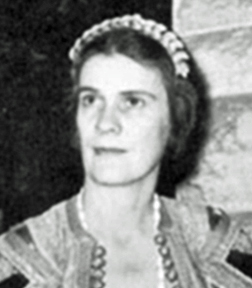
Olgivanna Lloyd Wright was the third and final wife of architect Frank Lloyd Wright, whom she met in November 1924. The two married in 1928, founded Wright's architectural apprentice program, the Taliesin Fellowship, in 1932, and, the Frank Lloyd Wright Foundation in 1940. Olgivanna became the President of the Frank Lloyd Wright Foundation upon her husband's death in 1959 and remained president until a month before her own death in 1985.

Seven Were Saved is a 1947 American film directed by William H. Pine and starring Richard Denning, Catherine Craig and Russell Hayden. The film's opening title says: "This film is dedicated to the men of the AAF Air-sea rescue service, who risk their lives daily that others may live." Seven Were Saved was the first of a number of films that dramatized survival at sea after an aircraft crash.
David Stuart Horner was a crime fiction novelist and the longtime partner of Osbert Sitwell.
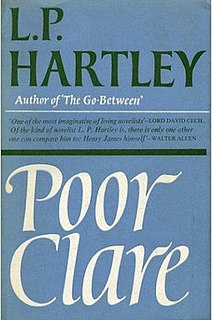
Poor Clare is a 1968 novel by the British writer L.P. Hartley. After inheriting some fine works of art from his aunt, a composer surprises everyone when he gives them away to his friends, leading all to wonder if there is some ulterior motive.

The Harness Room is a 1971 novel by the British writer L.P. Hartley. A retired colonel about to remarry decides that his seventeen-year-old son needs toughening up and while away on his honeymoon has his chauffeur, an ex-guardsman to instruct him in boxing and other sports in the harness room. The two men come to develop a bond.
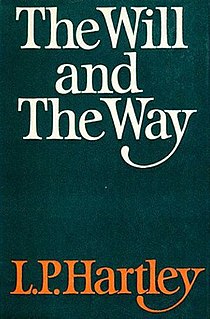
The Will and the Way is a 1973 novel by the British writer L.P. Hartley. It was his final novel, published posthumously following his death in 1972.
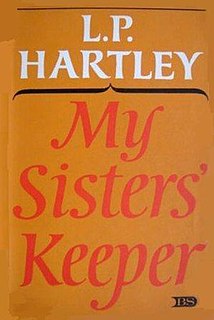
My Sisters' Keeper is a 1970 novel by the British writer L.P. Hartley.
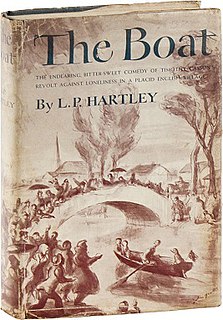
The Boat is a 1949 novel by British writer L.P. Hartley. An English writer returns home from Venice, and takes residence in a house by a river where he can indulge his passion in rowing.
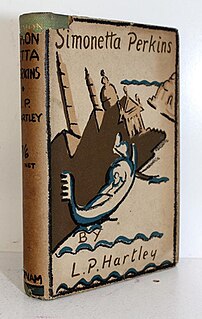
Simonetta Perkins is a 1925 novella by the British writer L.P. Hartley. A young Bostonian woman visiting Venice with her overbearing mother, quickly goes tired of her fellow American tourists and begins to fixate on a handsome gondolier she sees.

The Hireling is a 1957 novel by the British writer L.P. Hartley. A widowed aristocrat bonds with the ex-soldier who drives his own car in a chauffeur service.
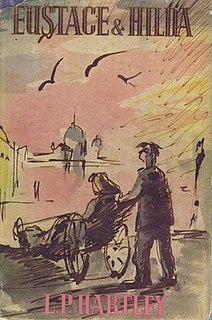
Eustace and Hilda is a 1947 novel by the British writer L.P. Hartley. It was the third in a trilogy of novels, following The Shrimp and the Anemone (1944) and The Sixth Heaven (1946), which are collectively known as the Eustace and Hilda Trilogy.
















